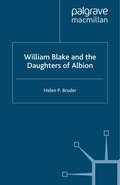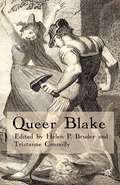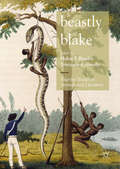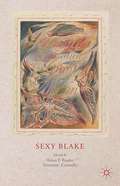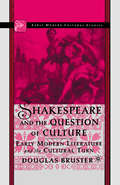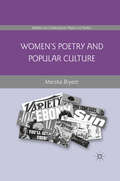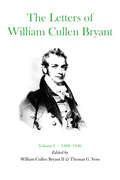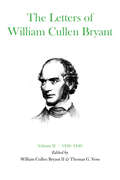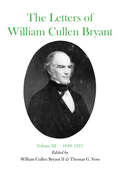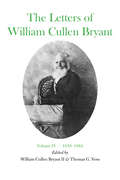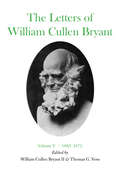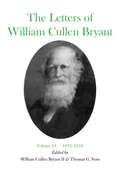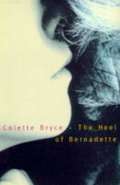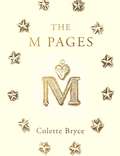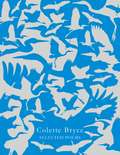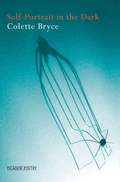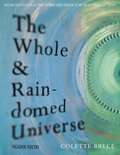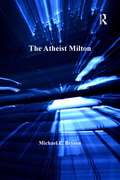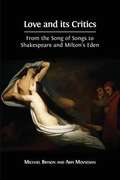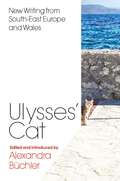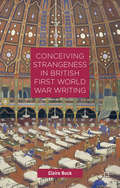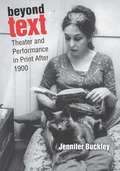- Table View
- List View
William Blake and the Daughters of Albion
by H. BruderWilliam Blake and the Daughters of Albion offers a challenge to the Blake establishment. By placing some of Blake's early prophetic works in startingly new historical contexts (most provocatively those of female conduct and pornography) a very different image of the radical Blake emerges. The book shows what can be achieved when a challenging methodology, feminist historicism, is brought to bear on a canonical writer and on now canonized interpretations of his work.
Queer Blake
by H. Bruder T. ConnollyNumerous claims have been made for a sexual Blake, from post-lapsarian pessimist to free-loving hippie. Queer Blake raises a flag for the weird, perverse, camp and gay directions of the artist's life and work. The contributors occupy diverse positions, illustrating what fresh interpretations result when heterosexuality is ditched as an ideal.
Beastly Blake (Palgrave Studies in Animals and Literature)
by Helen P. Bruder Tristanne ConnollyBlake’s ‘Human Form Divine’ has long commanded the spotlight. Beastly Blake shifts focus to the non-human creatures who populate Blake’s poetry and designs. The author of ‘The Tyger’ and ‘The Lamb’ was equally struck by the ‘beastliness’ and the beauty of the animal kingdom, the utter otherness of animal subjectivity and the meaningful relationships between humans and other creatures. ‘Conversing with the Animal forms of wisdom night & day’, Blake fathomed how much they have to teach us about creation and eternity. This collection ranges from real animals in Blake’s surroundings, to symbolic creatures in his mythology, to animal presences in his illustrations of Virgil, Dante, Hayley, and Stedman. It makes a third to follow Queer Blake and Sexy Blake in irreverently illuminating blind spots in Blake criticism. Beastly Blake will reward lovers of Blake’s writing and visual art, as well as those interested in Romanticism and animal studies.
Beastly Blake (Palgrave Studies in Animals and Literature)
by Helen P. Bruder Tristanne ConnollyBlake’s ‘Human Form Divine’ has long commanded the spotlight. Beastly Blake shifts focus to the non-human creatures who populate Blake’s poetry and designs. The author of ‘The Tyger’ and ‘The Lamb’ was equally struck by the ‘beastliness’ and the beauty of the animal kingdom, the utter otherness of animal subjectivity and the meaningful relationships between humans and other creatures. ‘Conversing with the Animal forms of wisdom night & day’, Blake fathomed how much they have to teach us about creation and eternity. This collection ranges from real animals in Blake’s surroundings, to symbolic creatures in his mythology, to animal presences in his illustrations of Virgil, Dante, Hayley, and Stedman. It makes a third to follow Queer Blake and Sexy Blake in irreverently illuminating blind spots in Blake criticism. Beastly Blake will reward lovers of Blake’s writing and visual art, as well as those interested in Romanticism and animal studies.
Sexy Blake
by Helen P. Bruder Tristanne ConnollyThis book lays bare numerous sexy Blakes, arguing for both chastity and pornography, violence and domination as well as desire and redemption, and also journeying in the realms of conceptual sex and conceptual art. Fierce tussles over the body in, and the body of, the poet-artist's work celebrate Blakean attractions and repulsions.
Shakespeare and the Question of Culture: Early Modern Literature and the Cultural Turn (Early Modern Cultural Studies 1500–1700)
by D. BrusterThe last two decades have witnessed a profound change in the way we receive the literary texts of early modern England. One could call this a move from 'text' to 'culture'. Put briefly, earlier critics tended to focus on literary texts, strictly conceived: plays, poems, prose fictions, essays. Since the mid-1980s, however, it has been just as likely for critics to speak of the 'culture' of early modern England, even when they do so in conjunction with analysis of literary texts. This 'cultural turn' has clearly enriched the way in which we read the texts of early modern England, but the interdisciplinary practices involved have frequently led critics to make claims about materials - and about the 'culture' these materials appear to embody - that exceed those materials' representativeness. Shakespeare and the Question of Culture addresses the central issue of 'culture' in early modern studies through both literary history and disciplinary critique. Douglas Bruster argues that the 'culture' literary critiques investigate through the works of Shakespeare and other writers is largely a literary culture, and he examines what this necessary limitation of the scope of 'cultural studies' means for the discipline of early modern studies.
Women's Poetry and Popular Culture (Modern and Contemporary Poetry and Poetics)
by Marsha BryantBridging feminist and cultural studies, the book shows how British and American women poets often operate as cultural insiders. Individual chapters reassess major figures (H.D., Gwendolyn Brooks, Sylvia Plath), alternative modernist poets (Edith Sitwell, Stevie Smith), and contemporary poets (Ai, Carol Ann Duffy).
The Letters of William Cullen Bryant: Volume I, 1809–1836
by William Cullen BryantThis is the only collection ever made of Bryant's letters, two-thirds of which have never before been printed. Their publication was foreseen by the late Allan Nevin as "one of the most important and stimulating enterprises contributory to the enrichment of the nation's cultural and political life that is now within range of individual and group effort.William Cullen Bryant (1794–1878) was America's earliest national poet. His immediate followers—Longfellow, Poe, and Whitman—unquestionably began their distinguished careers in imitation of his verses. But Bryant was even more influential in his long career as a political journalist, and in his encouragement of American art, from his lectures at the National Academy of Design in 1828 to his evocation of the Metropolitan Museum of Art in 1870. Between the appearance of his first major poem, "Thanatopsis," in 1817, and his death sixty-one years later at the age of eight-three, Bryant knew and corresponded with an extraordinary number of eminent men and women. More than 2,100 of his know letters have already been recovered for the present edition.When William Cullen Bryant signed the first of 314 letters in the present volume, in 1809, he was a frail and shy farm boy of fourteen who had nonetheless already won some fame as the satirist of Thomas Jefferson. When he wrote the last, in 1836, he had become the chief poet of his country, the editor of its principal liberal newspaper, and the friend and collaborator of its leading artists and writers. His collected poems, previously published at New York, Boston, and London, were going into their third edition. His incisive editorials in the New York Evening Post were affecting the decisions of Andrew Jackson's administration. His poetic themes were beginning to find expression in the landscape paintings of Robert Weir, Asher Durand, and Thomas Cole.The early letters gathered here in chronological order give a unique picture of Cullen Bryant's youth and young manhood: his discipline in the classics preparatory to an all-too-brief college tenure; his legal study and subsequent law practice; the experiments with romantic versification which culminated in his poetic masterpieces, and those with the opposite sex which led to his courtship and marriage; his eager interest in the politics of the Madison and Monroe Presidencies, and his subsequent activities as a local politician and polemicist in western Massachusetts; his apprenticeship as magazine editor and literary critic in New York City, from which his later eminence as journalist was the natural evolution; the lectures on poetry and mythology which foreshadowed a long career as occasional orator; the collaboration in writing The Talisman, The American Landscape, and Tales of Glauber-Spa, and in forming the National Academy of Design, and the Sketch Club, which brought him intimacy with writers, artists, and publishers; his first trip to the Aemrican West, and his first long visit to Europe, during which he began the practice of writing letters to his newspaper which, throughout nearly half a century, proved him a perceptive interpreter of the distant scene to his contemporaries.Here, in essence, is the first volume of the autobiography of one whom Abraham Lincoln remarked after his first visit to New York City in 1860, "It was worth the journey to the East merely to see such a man." And John Bigelow, who of Bryant's many eulogists knew him best, said in 1878 of his longtime friend and business partner, "There was no eminent American upon whom the judgment of his countrymen would be more immediate and unanimous. The broad simple outline of his character and career had become universally familiar, like a mountain or a sea."
The Letters of William Cullen Bryant: Volume II, 1836–1849
by William Cullen BryantThe second volume of William Cullen Bryant's letters opens in 1836 as he has just returned to New York from an extended visit to Europe to resume charge of the New York Evening Post, brought near to failure during his absence by his partner William Leggett's mismanagement. At the period's close, Bryant has found in John Bigelow an able editorial associate and astute partner, with whose help he has brought the paper close to its greatest financial prosperity and to national political and cultural influence.Bryant's letters lf the years between show the versatility of his concern with the crucial political, social, artistic, and literary movements of his time, and the varied friendships he enjoyed despite his preoccupation with a controversial daily paper, and with the sustenance of a poetic reputation yet unequaled among Americans. As president of the New York Homeopathic Society, in letters and editorials urging widespread public parks, and in his presidency of the New York Society for the Abolition of the Punishment of Death, he gave attention to public health, recreation, and order. He urged the rights of labor, foreign and religious minorities, and free African Americans; his most powerful political effort of the period was in opposition to the spread of slavery through the conquest of Mexico. An early commitment to free trade in material goods was maintained in letters and editorials, and to that in ideas by his presidency of the American Copyright Club and his support of the efforts of Charles Dickens and Harriet Martineau to secure from the United States Congress and international copyright agreement.Bryant's first visit to Great Britain came at the height of his poetic and journalistic fame in 1845, bringing him into cordial intimacy with members of Parliament, scientists, journalists, artists, and writers. In detailed letters to his wife, published here for the first time, he describes the pleasures he took in breakfasting with the literary patron Samuel Rogers and the American minister Edward Everett, boating on the Thames with artists and with diarist Henry Crabb Robinson, spending an evening in the home of Leigh Hunt, and calling on the Wordsworths at Rydal Mount as well as in the distinctions paid him at a rally of the Anti-Corn-Law League in Covent Garden Theatre, and at the annual meeting in Cambridge of the British Association for the Advancement of Science.Equally fresh are most of the letters to prominent Americans, many of them his close friends, such as the two Danas, Bancroft, Cole, Cooper, Dewey, Dix, Downing, Durand, Forrest, Greenough, Irving, Longfellow, Simms, Tilden, Van Buren, and Weir. His letters to the Evening Post recounting his observations and experiences during travels abroad and in the South, West, and Northeast of the United States, which were copied widely in other newspapers and praised highly by many of their subscribers, are here made available to the present-day reader.
The Letters of William Cullen Bryant: Volume III, 1849–1857
by William Cullen BryantDuring the years covered in this volume, Bryant traveled more often and widely than at any comparable period during his life. The visits to Great Britain and Europe, a tour of the Near East and the Holy Land, and excursions in Cuba, Spain, and North Africa, as well as two trips to Illinois, he described in frequent letters to the Evening Post. Reprinted widely, and later published in two volumes, these met much critical acclaim, one notice praising the "quiet charm of these letters, written mostly from out-of-the-way places, giving charming pictures of nature and people, with the most delicate choice of words, and yet in the perfect simplicity of the true epistolary style."His absence during nearly one-fifth of this nine-year period reflected the growing prosperity of Bryant's newspaper, and his confidence in his editorial partner John Bigelow and correspondents such as William S. Thayer, as well as in the financial acumen of his business partner Isaac Henderson. These were crucial years in domestic politics, however, and Bryant's guidance of Evening Post policies was evident in editorials treating major issues such as the Compromise of 1850, the Fugitive Slave Law, the Kansas-Nebraska Bill, the rise of the Republican Party, and the Dred Scott Decision, as well as in his correspondence with such statesmen as Salmon P. Chase, Hamilton Fish, William L. Marcy, Edwin D. Morgan, and Charles Sumner. His travel letters and journalistic writings reflected as well his acute interest in a Europe in turmoil. In France and Germany he saw the struggles between revolution and repression; in Spain he talked with journalists, parliamentary leaders, and the future president of the first Spanish republic; in New York he greeted Louis Kossuth and Giuseppe Garibaldi.Bryant's close association with the arts continued. He sat for portraits to a dozen painters, among them Henry P. Gray, Daniel Huntington, Asher Durand, Charles L. Elliott, and Samuel Laurence. The landscapists continued to be inspired by his poetic themes. Sculptor Horatio Greenough asked of Bryant a critical reading of his pioneering essays on functionalism. His old friend, the tragedian Edwin Forrest, sought his mediation in what would become the most sensational divorce case of the century, with Bryant and his family as witnesses. His long advocacy of a great central park in New York was consummated by the legislature. And in 1852, his eulogy on the life of James Fenimore Cooper became the first of several such orations which would establish him as the memorialist of his literary contemporaries in New York.
The Letters of William Cullen Bryant: Volume IV, 1858–1864
by William Cullen BryantThe years just before and during the Civil War marked the high point of Bryant's influence on public affairs, which had grown steadily since the Evening Post had upheld the democratic Jacksonian revolution of the 1830s. A founder of the Free Soil Party in 1848 and the Republican Party in 1856, Bryant was lauded in 1857 by Virginia anti-slavery leader John Curtis Underwood, who wrote to Eli Thayer, "What a glory it would be to our country if it could elect this man to the Presidency-the country not he would be honored & elevated by such an event."In 1860 Bryant helped secure the Presidential nomination for Abraham Lincoln, and was instrumental in the choice of two key members of his cabinet, Salmon Chase as Secretary of the Treasury, and Gideon Welles as Secretary of the Navy. During disheartening delays and defeats in the early war years, direct communications from Union field commanders empowered his editorial admonitions to such a degree that the conductor of a national magazine concluded that the Evening Post's "clear and able political leaders have been of more service to the government of this war than some of its armies."Bryant's correspondence with statesmen further reflects the immediacy of his concern with military and political decisions. There are thirty-five known letters to Lincoln, and thirty-two to Chase, Welles, war secretary Stanton, and Senators Fessenden, Morgan, and Sumner.This seven-year passage in Bryant's life, beginning with his wife's critical illness at Naples in 1858, concludes with a unique testimonial for his seventieth birthday in November 1864. The country's leading artists and writers entertained him at a "Festival" in New York's Century Club, giving him a portfolio of pictures by forty-six painters as a token of the "sympathy" he had "ever manifested toward the Artists," and the "high rank" he had "ever accorded to art." Poets Emerson, Holmes, Longfellow, Lowell, and Whittier saluted him in prose and verse. Emerson saw him as "a true painter of the face of this country"; Holmes, as the "first sweet singer in the cage of our close-woven life." To Whittier, his personal and public life sounded "his noblest strain." And in the darkest hours of the war, said Lowell, he had "remanned ourselves in his own manhood's store," had become "himself our bravest crown."
The Letters of William Cullen Bryant: Volume V, 1865–1871
by William Cullen BryantOn April 26, 1865, as Abraham Lincoln's funeral cortege paused in Union Square, New York, before being taken by rail to Springfield, Illinois, William Cullen Bryant listened as his own verse elegy for the slain president was read to a great concourse of mourners by the Reverend Samuel Osgood. Only five years earlier and a few blocks downtown, at Cooper Union, Bryant had introduced the prairie candidate to his first eastern audience. There his masterful appeal to the conscience of the nation prepared the way for his election to the presidency on the verge of the Civil War. Now, Bryant stood below Henry Kirke Brown's equestrian statue of George Washington, impressing Osgood as if he were "the 19tth Century itself thinking over the nation and the age in that presence." Bryant's staunch support of the Union cause throughout the war, and of Lincoln's war efforts, no less than his known influence with the president, led several prominent public figures to urge that he write Lincoln's biography. Oliver Wendell Holmes wrote him, "No man combines the qualities for his biographer so completely as yourself and the finished task would be a noble crown to a noble literary life." But Bryant declined, declaring his inability to record impartially critical events in which he had taken so central a part. Furthermore, while preoccupied with the editorial direction of the New York Evening Post, he was just then repossessing and enlarging his family's homestead at Cummington, Massachusetts, where he hoped his ailing wife might, during long summers in mountain air, regain her health. But in July 1866, Frances died of recurrent rheumatic fever, and, Bryant confessed to Richard Dana, he felt as "one cast out of Paradise." After France's death Bryant traveled with his daughter Julia for nearly a year through Great Britain and the Continent, where he met British statesman and novelist Edward Bulwer Lytton and French literary critic Hyppolyte Taine, renewed his friendship with Spanish poet Carolina Coronado, Italian liberator Giuseppe Garibaldi, and British and American artists, and visited the family of the young French journalist Georges Clemenceau, as well as the graves of earlier acquaintances Francis Lord Jeffrey and Elizabeth Barrett Browning. In his spare moments Bryant sought solace by beginning the translation of Homer, and Longfellow had found relief after his wife's tragic death by rendering into English Dante's Divine Comedy. Home again in New York, Bryant bought and settled in a house at 24 West 16th Street which would be his city home for the rest of his life. Here he completed major publications, including the Iliad and Odyssey of Homer and an exhaustive Library of Poetry and Song, and added to published tributes to earlier friends, such as Thomas Cole, Fenimore Cooper, and Washington Irving, memorial discourses on Fitz-Greene Halleck and Gulian Verplanck. In addition to his continued direction of the New York Homeopathic Medical college and the American Free Trade League, he was elected to the presidency of the Williams College Alumni Association, the International Copyright Association, and the Century Association, the club of artists and writers of which, twenty years earlier, he had been a principal founder and which he would direct for the last decade of his life.
The Letters of William Cullen Bryant: Volume VI, 1872–1878
by William Cullen BryantIn January 1872, Bryant traveled to Mexico City, where he was greeted warmly by President Benito Juarez; on this and other occasions he was feted for the Evening Post's sturdy condemnation in 1863 of the abortive invasion of Mexico, which was freshly remembered there. AT the close of his visit a local newspaper remarked that the "honors and hospitality which were so lavishly and generously conferred upon him were the spontaneous outpouring of a grateful people, who had not forgotten that when Mexico was friendless Mr. Bryant became her friend." Returning in April through New Orleans and up the Mississippi by steamboat to Cincinnati, he was greeted at a public reception by Governor Rutherford Hayes, who was pleased by his "winning and lovable" manners and "pithy" anecdotes.That spring Bryant built a library for his birthplace, Cummington, stocking it with several thousand books procured for him by the publisher George Palmer Putnam in New York and London. The following year, after the last of his many travels - this time a revisit to South Carolina and Florida - he made a similar gift to Roslyn. These benefactions won him honorary membership in the newly formed American Library Association, and an invitation to open a library at Princeton University, which made him an honorary doctor of letters. Ultimately, in the final year of his life, his plans for the Bryant Library at Cummington, solicited from the White House by President Hayes, provided the basic design for the first presidential library in the country - that established by Hayes in Fremont, Ohio.An improbable by-product of the presidential race in 1872 was a proposal by leading journalists that Bryant become -in his seventy-eighth year - a candidate to oppose President Grant and his challenger for the Republican nomination, the mercurial editor of the New York Tribune, Horace Greeley. Bryant's immediate refusal to take the suggestion seriously was succinct, and tinged with humor. It was impossible, he declared in his newspaper, that he should receive the nomination, and "equally impossible," if it were offered, that he should "commit the folly of accepting it." Four years later he was distressed at being unable to switch his journal's support of the Republican candidate Hayes to the Democratic candidate, his old companion in political reform, Samuel Jones Tilden.As Bryant approached and entered his eighties, his writing and public speaking continued without slackening. Between 1872 and 1878 he published his collected Orations and Addresses, edited a revision of his anthology of poetry and two volumes of landscape sketches, Picturesque America, co-authored a four-volume Popular History of the United States, and undertook to co-edit a three-volume set of Shakespeare's plays, while also producing long monographs on several seventeenth-century English poets. He dedicated statues of Shakespeare, Walter Scott, and Fitz-Green Halleck in Central Park, and spoke elsewhere on Robert Burns, Benjamin Franklin, Goethe, and Shakespeare, gave speeches on Mexico and "National Honesty," and presided over the founding of the State Charities Aid Association. He was honored in Albany at receptions by each house of the legislature. For his eightieth birthday, his life's work was celebrated in silver on a Tiffany vase given him by admirers throughout the country.Bryant's last public act was to unveil, in Central Park, his brainchild of nearly a half century earlier: a bust of the Italian patriot Giuseppe Mazzini. Here, after exhaustion under the June sun, he fell and suffered a massive concussion followed by a stroke, which led to his death a fortnight later in his eighty-fourth year. A period of virtual national mourning preceded his funeral and his burial beside his wife at Roslyn. At one of many memorial services, a eulogist exclaimed, "The broad outline of his character had become universally familiar, like a mountain or a sea. Whoever saw Bryant saw America."
The Heel of Bernadette
by Colette BryceColette Bryce’s first collection is a book of songs: songs of kinship and desire, Ireland and Spain, of myth and belief. Bryce's sensuous and sinuous verse follows the convoluted lines of fate and political divide, and turns on questions of love and faith – the poet’s relentlessly clarifying sense leaving them strengthened or shaken. In its insistent music – whatever dark and surreal turns it might take – Bryce’s poetry is ultimately a celebration of singing and of singing out, for its own sake. The Heel of Bernadette announces one of the most unusual and distinctive voices to have emerged from Northern Ireland for a generation.
The M Pages
by Colette BryceThe reader might be justified in thinking that the M in the title of Colette Bryce's new poetry collection could stand for Mortality, Mother, Mourning, or the spontaneous and cathartic practice of the writer’s ‘morning pages’ – until they reach the book’s arresting central sequence. Addressed to ‘M’, a sibling who has suddenly died, this three-part poem depicts the experience of unexpected bereavement, and the altering effect such events have on the living. It does so unflinchingly, gracefully and honestly, as Bryce harnesses her characteristic insight, forensic eye and deeply-woven music to deeply moving ends. As the book unfolds, it becomes clear that her other subjects (of family, travel, history and ageing) all orbit the gravitational centre of The M Pages. This is a important book about what – for reasons of propriety, self-censorship, fear and the limits of our knowledge – we can and cannot say about one of the most profound events we can face.
Selected Poems
by Colette BryceShortlisted for the Poetry Pigott Prize in association with Listowel Writers’ WeekThrough four highly acclaimed collections, Colette Bryce has steadily consolidated her position as one of the most important of the younger generation of Irish poets. Possessed of a preternaturally acute ear and eye, Bryce is the recorder and observer of tense times: perhaps no contemporary poet has better mapped the fault-lines of nation and family, of love and tribal loyalty, of landscape and border. In all this, Bryce again and again declares the primacy of song as a redemptive practice, and a glorious end in itself: no voice is more accurately pitched or effortlessly musical. Selected Poems draws together the best of her poetry from The Heel of Bernadette to The Whole & Rain-domed Universe, winner of the Ewart-Biggs Award, and is a marvellous introduction to the range and sweep of Bryce’s work.
Self-Portrait in the Dark
by Colette BryceThe dark attunes our eyes to detail the light can sometimes conceal; similarly, Colette Bryce’s new poems are ‘slant tellings’ that reveal strange and true reflections. Using a wide range of imaginative strategies, Bryce examines the ways in which time is held, space enclosed – and a life framed and given meaning: a face in a broken mirror, a spider trapped under a glass, or a stolen kiss in a car-wash. Bryce’s two previous prize-winning collections were widely admired for their marvellously seductive music and their speed of thought; Self-Portrait in the Dark widens and deepens the poet’s scope, and is her most emotionally compelling collection to date. Praise for The Full Indian Rope Trick ‘[Bryce’s] poems, sensitive as the needle that registers some distant earth tremor, are delicately poised . . . Bryce’s vision is questing, disquieting, dark . . . as she seeks out the truths of life and love that transform the human heart. This is a confident, complex, subversive collection that shows us the magic by which one becomes a mature poet’ The Times
The Whole & Rain-domed Universe
by Colette BryceThe Whole & Rain-domed Universe is Colette Bryce's much-anticipated follow-up to Self-Portrait in the Dark. The book presents the reader with an extraordinarily clear-eyed, vivid and sometimes disturbing account of growing up in Derry during the Troubles, with many ghosts both raised and laid to rest. The Whole & Rain-domed Universe is a riveting poetic document of the time; Bryce turns her clear, singing line to darker ends than she has before, describing not just the warmth and eccentricity of family and the claustrophobia of home-life, but also the atmosphere of suspicion, and the real and present threat of terrible violence. Bryce is one of the most widely acclaimed poets of the post-Heaney generation, and this is her most directly personal and compelling work to date.
The Atheist Milton
by Michael E. BrysonBasing his contention on two different lines of argument, Michael Bryson posits that John Milton-possibly the most famous 'Christian' poet in English literary history-was, in fact, an atheist. First, based on his association with Arian ideas (denial of the doctrine of the Trinity), his argument for the de Deo theory of creation (which puts him in line with the materialism of Spinoza and Hobbes), and his Mortalist argument that the human soul dies with the human body, Bryson argues that Milton was an atheist by the commonly used definitions of the period. And second, as the poet who takes a reader from the presence of an imperious, monarchical God in Paradise Lost, to the internal-almost Gnostic-conception of God in Paradise Regained, to the absence of any God whatsoever in Samson Agonistes, Milton moves from a theist (with God) to something much more recognizable as a modern atheist position (without God) in his poetry. Among the author's goals in The Atheist Milton is to account for tensions over the idea of God which, in Bryson's view, go all the way back to Milton's earliest poetry. In this study, he argues such tensions are central to Milton's poetry-and to any attempt to understand that poetry on its own terms.
The Atheist Milton
by Michael E. BrysonBasing his contention on two different lines of argument, Michael Bryson posits that John Milton-possibly the most famous 'Christian' poet in English literary history-was, in fact, an atheist. First, based on his association with Arian ideas (denial of the doctrine of the Trinity), his argument for the de Deo theory of creation (which puts him in line with the materialism of Spinoza and Hobbes), and his Mortalist argument that the human soul dies with the human body, Bryson argues that Milton was an atheist by the commonly used definitions of the period. And second, as the poet who takes a reader from the presence of an imperious, monarchical God in Paradise Lost, to the internal-almost Gnostic-conception of God in Paradise Regained, to the absence of any God whatsoever in Samson Agonistes, Milton moves from a theist (with God) to something much more recognizable as a modern atheist position (without God) in his poetry. Among the author's goals in The Atheist Milton is to account for tensions over the idea of God which, in Bryson's view, go all the way back to Milton's earliest poetry. In this study, he argues such tensions are central to Milton's poetry-and to any attempt to understand that poetry on its own terms.
Love and its Critics: From the Song of Songs to Shakespeare and Milton’s Eden
by Michael Bryson Arpi MovsesianThis book is a history of love and the challenge love offers to the laws and customs of its times and places, as told through poetry from the Song of Songs to John Milton’s Paradise Lost. It is also an account of the critical reception afforded to such literature, and the ways in which criticism has attempted to stifle this challenge. Bryson and Movsesian argue that the poetry they explore celebrates and reinvents the love the troubadour poets of the eleventh and twelfth centuries called fin’amor: love as an end in itself, mutual and freely chosen even in the face of social, religious, or political retribution. Neither eros nor agape, neither exclusively of the body, nor solely of the spirit, this love is a middle path. Alongside this tradition has grown a critical movement that employs a 'hermeneutics of suspicion', in Paul Ricoeur’s phrase, to claim that passionate love poetry is not what it seems, and should be properly understood as worship of God, subordination to Empire, or an entanglement with the structures of language itself – in short, the very things it resists. The book engages with some of the seminal literature of the Western canon, including the Bible, the poetry of Ovid, and works by English authors such as William Shakespeare and John Donne, and with criticism that stretches from the earliest readings of the Song of Songs to contemporary academic literature. Lively and enjoyable in its style, it attempts to restore a sense of pleasure to the reading of poetry, and to puncture critical insistence that literature must be outwitted. It will be of value to professional, graduate, and advanced undergraduate scholars of literature, and to the educated general reader interested in treatments of love in poetry throughout history.
Love and its Critics: From the Song of Songs to Shakespeare and Milton’s Eden (PDF)
by Michael Bryson Arpi MovsesianThis book is a history of love and the challenge love offers to the laws and customs of its times and places, as told through poetry from the Song of Songs to John Milton’s Paradise Lost. It is also an account of the critical reception afforded to such literature, and the ways in which criticism has attempted to stifle this challenge. Bryson and Movsesian argue that the poetry they explore celebrates and reinvents the love the troubadour poets of the eleventh and twelfth centuries called fin’amor: love as an end in itself, mutual and freely chosen even in the face of social, religious, or political retribution. Neither eros nor agape, neither exclusively of the body, nor solely of the spirit, this love is a middle path. Alongside this tradition has grown a critical movement that employs a 'hermeneutics of suspicion', in Paul Ricoeur’s phrase, to claim that passionate love poetry is not what it seems, and should be properly understood as worship of God, subordination to Empire, or an entanglement with the structures of language itself – in short, the very things it resists. The book engages with some of the seminal literature of the Western canon, including the Bible, the poetry of Ovid, and works by English authors such as William Shakespeare and John Donne, and with criticism that stretches from the earliest readings of the Song of Songs to contemporary academic literature. Lively and enjoyable in its style, it attempts to restore a sense of pleasure to the reading of poetry, and to puncture critical insistence that literature must be outwitted. It will be of value to professional, graduate, and advanced undergraduate scholars of literature, and to the educated general reader interested in treatments of love in poetry throughout history.
Ulysses's Cat: New Writing from South-East Europe and Wales
by Alexandra Büchler'A wonderful collection stemming from a hugely important project keeping young Welsh writers connected to Europe despite all attempts to sever these crucial cultural ties.' – Rachel Trezise 'Anthologies such as this one are the footings of the recently-burnt bridges that we need to rebuild. They help to tear down the walls put up around us. Always important, they are now vital.' – Niall Griffiths Ulysses's Cat brings readers the work of some of the most outstanding authors of the younger generation from Croatia, Greece, Serbia, Slovenia and Wales who participated in a project of exchange residencies originally launched on the Croatian island of Mljet, where, according to legend, shipwrecked Ulysses found shelter. As Britain becomes metaphorically unmoored and drifts away from Europe, keeping connected through reading and dialogue provides us with new perspectives on our place in the world and on the tumultuous times we live in. The works of poetry, prose and essays included here offer a snapshot of the concerns and preoccupations shared by young writers from a region with a rich literature that rarely reaches English-language readers and at the same time confirms the vitality of the bilingual Welsh literary scene.
Conceiving Strangeness in British First World War Writing
by C. BuckThis book reframes British First World War literature within Britain's history as an imperial nation. Rereading canonical war writers Siegfried Sassoon and Edmund Blunden, alongside war writing by Enid Bagnold, E. M. Forster, Mulk Raj Anand, Roly Grimshaw and others, the book makes clear that the Great War was more than a European war.
Beyond Text: Theater and Performance in Print After 1900
by Jennifer BuckleyTaking up the work of prominent theater and performance artists, Beyond Text reveals the audacity and beauty of avant-garde performance in print. With extended analyses of the works of Edward Gordon Craig, German expressionist Lothar Schreyer, the Living Theatre, Carolee Schneemann, and Guillermo Gómez-Peña, the book shows how live performance and print aesthetically revived one another during a period in which both were supposed to be in a state of terminal cultural decline. While the European and American avant-gardes did indeed dismiss the dramatic author, they also adopted print as a theatrical medium, altering the status, form, and function of text and image in ways that continue to impact both the performing arts and the book arts. Beyond Text participates in the ongoing critical effort to unsettle conventional historical and theoretical accounts of text-performance relations, which have too often been figured in binary, chronological (“from page to stage”), or hierarchical terms. Across five case studies spanning twelve decades, Beyond Text demonstrates that print—as noun and verb—has been integral to the practices of modern and contemporary theater and performance artists.
